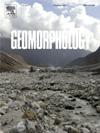Thousands of shallow, relict gullies indicate thermo-erosion on the sandy uplands of northern Lower Michigan during the Late Pleistocene
IF 3.1
2区 地球科学
Q2 GEOGRAPHY, PHYSICAL
引用次数: 0
Abstract
We build on previous work which explained the origin of myriad gullies and incised channels on the dry, sandy uplands of northern Lower Michigan by invoking widespread permafrost. Indicators of permafrost (ice-wedge casts and patterned ground) are known from many sites across the region. Our study area, within an extensive reentrant of the retreating Laurentide Ice Sheet, had been particularly well positioned, geographically, for permafrost. Our goal was to characterize the geomorphic characteristics of the gullies on 72 large ridges, to address the hypothesis that they had formed in association with permafrost. Across the study area, thousands of dry, narrow channels and gullies occur in dense networks, typically with channels aligned directly downslope, in parallel drainage patterns. Most of the gullies exhibit only a minimal amount of incision (ca. 2–3 m), a nearly straight longitudinal profile, and lack a clear depositional fan at their mouth. Even where small fans are present, they are subtle and exhibit little down-fan textural sorting, as would be present in larger, more mature fluvial systems. Gully morphologies did not exhibit strong morphological differences as a function of aspect, as we would have expected for an erosional, periglacial system forming on fairly steep slopes. Nonetheless, in these sandy/gravelly sediments, we could find no other scenario that would have allowed for runoff and gully formation, except ice-rich permafrost that limited infiltration and promoted saturation of the active layer, and eventually, runoff. We conclude that the gullies formed via thermo-erosion into ice-rich permafrost, involving mostly fluvial processes but also some slope failure. Even though thermo-erosion can rapidly form deep gullies, our study area has mainly weak gully forms, perhaps because: (1) permafrost existed here only briefly, (2) the landscape was so cold and the permafrost so ice-rich that runoff was rare, (3) the permafrost on the sandy slopes remained somewhat permeable, limiting runoff, and/or (4) the paleoclimate was so dry that little water was available for sediment transport. We could find no evidence that the gullies developed within preexisting polygonal networks, as is happening today in polar regions under a warming climate. Thus, our study has implications for areas of the Arctic and Antarctic that are, today, experiencing rapid hydrological changes.
数以千计的浅层遗迹沟壑表明,下密歇根州北部的沙质高地在晚更新世发生了热侵蚀作用
我们在之前工作的基础上,通过援引大面积的永久冻土,解释了下密歇根州北部干燥的沙质高地无数沟壑和切槽的起源。该地区许多地点都有永久冻土的迹象(冰楔和图案地面)。我们的研究区域位于正在后退的劳伦泰德冰原的大面积重熔区内,从地理位置上看,该区域的永久冻土尤为突出。我们的目标是确定 72 个大型山脊上沟壑的地貌特征,以解决这些沟壑与永久冻土层共同形成的假设。在整个研究区域,数以千计的干燥、狭窄的沟道和冲沟形成了密集的网络,通常沟道直接向下排列,形成平行的排水模式。大多数沟壑只有极少量的切口(约 2-3 米),纵向剖面近乎笔直,沟口处缺乏明显的沉积扇。即使在有小扇面的地方,它们也很微妙,几乎没有表现出顺扇纹理分选,这在更大、更成熟的河流系统中会出现。沟谷形态并没有表现出强烈的形态差异,这与我们对在相当陡峭的斜坡上形成的侵蚀性围冰期系统的预期不同。尽管如此,在这些砂质/砾质沉积物中,除了富含冰的永久冻土限制了渗透并促进了活动层的饱和,最终形成径流之外,我们找不到其他能够形成径流和沟壑的情况。我们的结论是,这些沟壑是通过热侵蚀作用形成的,进入富冰永久冻土层,主要涉及河道过程,但也有一些斜坡崩塌。尽管热侵蚀作用可以迅速形成深沟,但我们的研究区域主要形成了较弱的沟壑,这可能是因为:(1) 这里的永久冻土存在时间很短;(2) 地形非常寒冷,永久冻土富含冰,因此很少有径流;(3) 沙质山坡上的永久冻土仍有一定的渗透性,限制了径流;和/或 (4) 古气候非常干燥,几乎没有水可供沉积物迁移。我们没有发现任何证据表明,这些沟壑是在原有的多边形网络中形成的,就像今天气候变暖下极地地区的情况一样。因此,我们的研究对今天正在经历快速水文变化的北极和南极地区具有重要意义。
本文章由计算机程序翻译,如有差异,请以英文原文为准。
求助全文
约1分钟内获得全文
求助全文
来源期刊

Geomorphology
地学-地球科学综合
CiteScore
8.00
自引率
10.30%
发文量
309
审稿时长
3.4 months
期刊介绍:
Our journal''s scope includes geomorphic themes of: tectonics and regional structure; glacial processes and landforms; fluvial sequences, Quaternary environmental change and dating; fluvial processes and landforms; mass movement, slopes and periglacial processes; hillslopes and soil erosion; weathering, karst and soils; aeolian processes and landforms, coastal dunes and arid environments; coastal and marine processes, estuaries and lakes; modelling, theoretical and quantitative geomorphology; DEM, GIS and remote sensing methods and applications; hazards, applied and planetary geomorphology; and volcanics.
 求助内容:
求助内容: 应助结果提醒方式:
应助结果提醒方式:


